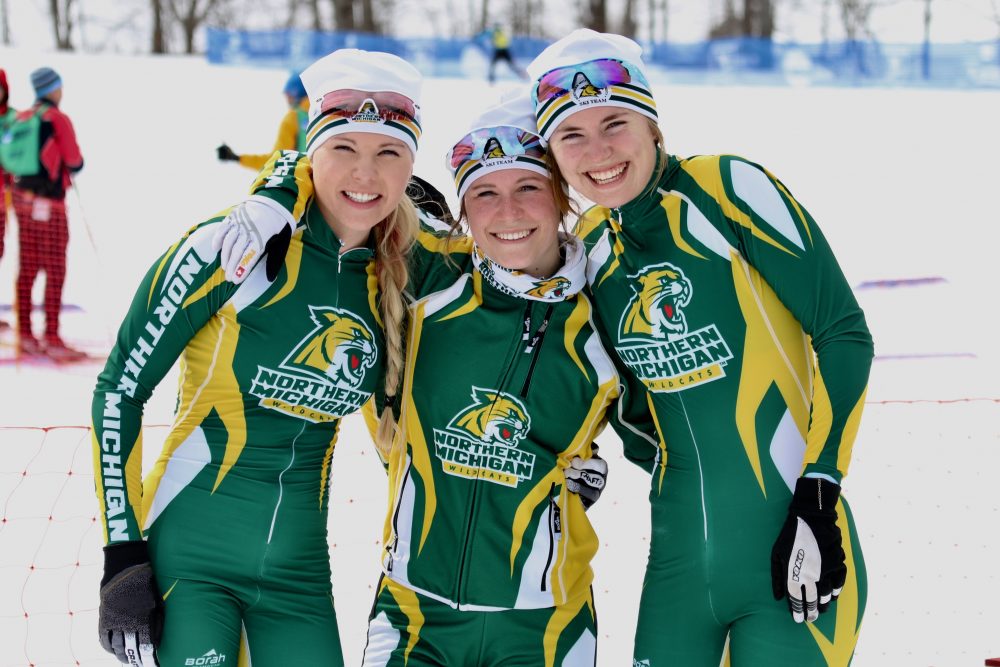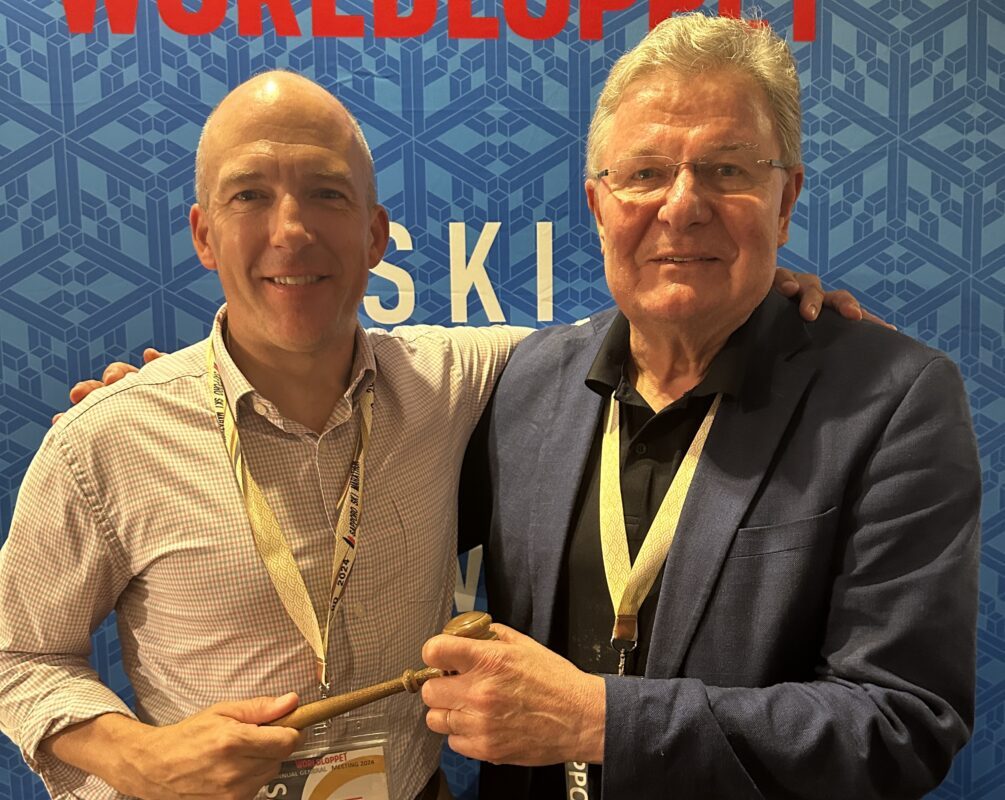
Two-and-half months into her summer training last year, Kristen Bourne woke up in a cold sweat. Her temperature read higher than normal and no amount of lozenges could soothe her sore throat. The Northern Michigan University (NMU) skier went to a doctor and received antibiotics to treat what was thought to be strep throat.
But two weeks later, Bourne still didn’t feel like herself, and she wanted to know why.
Behind her were 215 logged hours of summer training in Marquette, Mich., a 6 1/2 hour drive from her hometown of Lake Elmo near Stillwater, Minn.
Ahead of her was a promising junior season at NMU, with plans to attend the university’s sports-science graduate program in the winter of 2018. She had redshirted the year before and gained an extra year of development under NMU Head Nordic Coach Sten Fjeldheim, as well as an extension on her National Collegiate Athletic Association (NCAA) eligibility.
The investment she had put in her season was nothing to scoff at; neither was her uncharacteristic exhaustion at practice. After finishing one session in late August feeling especially spent, Bourne returned to the doctor, and this time, was able to pinpoint the issue.
“I went to the doctor that day and they did a mono test,” Bourne explained on the phone.

The results tested positive. With fall training just around the corner, and a sudden uncertainty about where she was headed, Bourne began to worry. What did this mean for her season? Was there any way out? Were all those hours of work and training for nothing?
“I was so bummed,” Bourne, who turns 22 later this month, said. “It was the best I had felt training; when you put in all this work and then realize that you’re not going to do anything and for that long, it’s really concerning.”
The mononucleosis put her out of training for two months, from the beginning of September until the end of October. These months are not dispensable as they often incorporate a new cycle of intensity sessions, hours and gym time.
But for Bourne, it was the beginning of a learning process and careful track back to top form, thanks in part to Fjeldheim and his connection to the NMU sports-science department.
The First: Fielding Mono with Fjeldheim
What exactly is mono? How does it affect athletes? How might it affect athletes as they return to training?
These were some of the questions Fjeldheim had when he encountered his first case of mono among his student athletes. While coaching NMU’s cross-country running team, one of his top runners came down with the illness at the end of the summer. (Fjeldheim coached for the NMU running program for more than 20 years, and now solely coaches nordic).
With the cross-country running season only lasting about eight weeks, there was limited time before some of the more important scoring races, like regionals, appeared next on the calendar.
Fjeldheim wasn’t deterred. He approached Dr. Phil Watts, NMU’s sports-science program coordinator and professor. Sitting in Watts’s office — a room Fjeldheim had visited when he was a Wildcat — the two discussed the costs and benefits of de-training to the body and ultimately developed a way to help the runner make a full recovery.
“We laid out a plan with the team doctor on how to bring her back,” Fjeldheim said. “I think she got [mono] in early August and then by early November we ran our regionals and she got third. That’s after running only one other running race before the regionals. I think she ran a running race at the end of October and then second week in November, she’s third in our regionals.”

After that, Fjeldheim worked with a few other athletes who came down with mono early in their season yet went on to become All-American athletes. Though Bourne would not earn this accolade, she came close.
By the end of her season, Bourne won both races at the Central Collegiate Ski Association (CSSA) Distance Championships and also qualified for NCAA Skiing Championships. There in Jackson, N.H., she finished 17th in the 5 k classic and was the top NMU woman in the 15 k freestyle mass start two days later, placing 13th and within two seconds of All-American status (top 10).
All after having mono. How?
Bourne’s comeback was not without meticulous and methodical planning. Her return to training was slow and her situation was unique: not only did her coach, Fjeldheim, have experience working with athletes who had mono and successfully returned to racing, but Bourne was also the type of athlete who made the return more amenable.
Over the course of an entire summer, Bourne routinely checked her heart rate each morning, before getting out of bed. She wrote it down and kept track of fluctuations and differences. Every day.
When she was diagnosed with mono, knowing her base heart rate was crucial. After two months off and having her spleen examined to ensure it was no longer enlarged, she started exercising again. Each week entailed meetings with coaches and every day, she assessed her resting heart rate and how far off it was from her previous one.
“We used the morning heart rate as a guide,” Fjeldheim explained. “Once her morning heart rates were back to normal, within say two or three beats of what her base morning heart rate had been for months and possibly years, then we just started with getting back into moving again.”
He emphasized that this came after making sure Bourne’s spleen was a normal size. Then she safely began training again while agreeing to listen to what her body was telling her via her heartbeat and lactate tests. And she had to keep it to a minimum.
“When I started working out, it was 15-minute jogs,” Bourne said. “Then every week, I’d sit down with my coaches and re-evaluate how I felt, how that week went. Every two weeks I was doing some lactate tests to monitor my heart-rate zones … then every week adding a little bit if I was ready. Come November, I started actually doing more systematic training instead of just doing low distance.”
Fjeldheim also monitored Bourne’s sleep patterns to make sure there weren’t disruptions and whether she was gaining or losing weight.
If any of the numbers were off, she rested.
“You don’t mess with mono,” Bourne emphasized. “If you don’t feel good, you do nothing. You can’t try and push it out of your system it just doesn’t work that way.”

This perhaps was the hardest part. While Bourne rested in bed, her teammates were out training. When Bourne finally began training an hour and a half again, her teammates were out doing three. She missed out on more than three months of interval training. And when she did reincorporate hard efforts, she didn’t always feel good.
“Mentally, it’s really tough,” Bourne said. “I just had to trust what my coaches said and trust myself and keep my fingers crossed and hope that my season would work out. We figured that I wouldn’t start doing well until February because I didn’t actually start doing intervals until the end of November. … I have to give so much credit to my coaches reassuring me all the time and my teammates being so supportive about it, being like, Kristen if anyone can do it, you can do it.”
Rather than get caught up in what training she couldn’t do, Fjeldheim advised Bourne to focus on what she could do, like improving her technique.
“As I told her, hey you know, you’re going to come back from this. It’s not cancer, it’s not debilitating, you didn’t find out you’ve got some rare disease,” he said. “You have mono and we’re going to figure out a plan. You got to have a plan and then they got to buy into it.”
The experience gave Bourne not only some of her best collegiate results, but also a new edge on her training. She plans to ski for NMU next winter and is considering continuing to race competitively after she graduates.
“A lot can happen in a year and I can’t set any expectations for myself right now,” Bourne wrote in an email. “We’ll just have to wait and see!”
***
Author’s note: This article is not intended to be a guide on how to train through mono, but rather track one athlete’s recovery from illness.
Gabby Naranja
Gabby Naranja considers herself a true Mainer, having grown up in the northern most part of the state playing hockey and roofing houses with her five brothers. She graduated from Bates College where she ran cross-country, track, and nordic skied. She spent this past winter in Europe and is currently in Montana enjoying all that the U.S. northwest has to offer.



